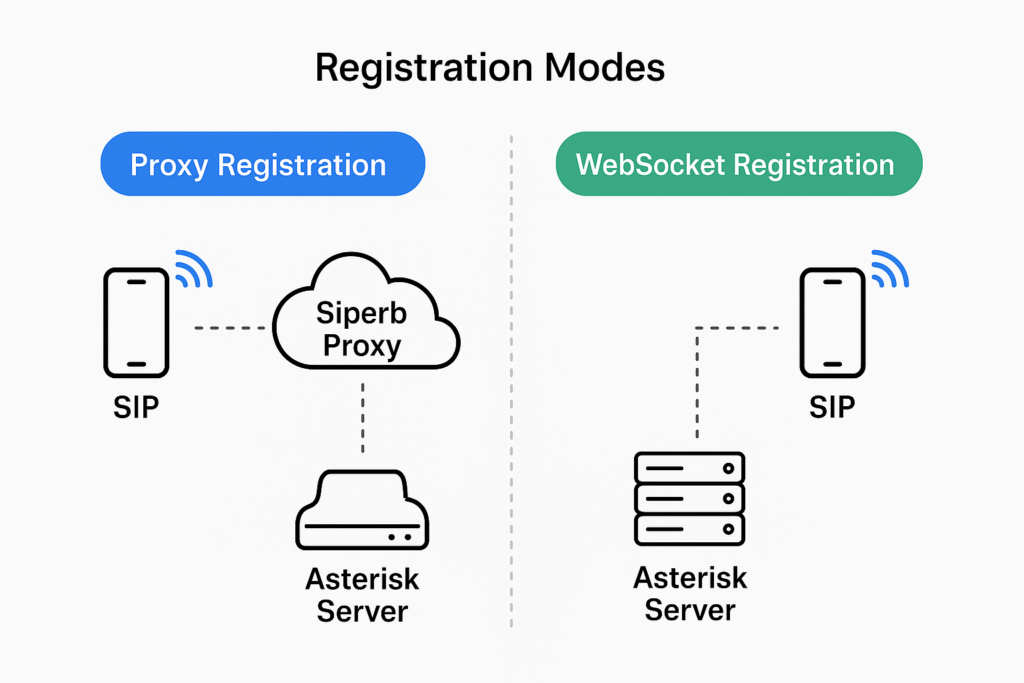Siperb offers two flexible Registration Modes to suit your deployment needs: Proxy Registration and WebSocket Registration. These modes determine how your device connects to your SIP infrastructure, while still supporting full device provisioning in both cases — so your users always enjoy a seamless setup experience, no matter the mode.
Proxy Registration Mode (Default)
With Proxy Registration, devices connect to your PBX through the Siperb SIP Proxy. This mode unlocks the full suite of features that Siperb is known for, including:
- Full provisioning with SIP credentials, proxy settings, and media configuration
- SIP over WebRTC with SRTP support
- SIP Trace, Latency & Register Logs for diagnostics and analytics
- Built-in Media Transcoding for legacy PBXs
- Mobile Push Notifications for low-power background operation
Trade-offs:
- Device State Subscriptions not supported (SUBSCRIBE)
- No Presence Status (PUBLISH)
WebSocket Registration Mode
In WebSocket Registration, devices register directly with your Asterisk server over a secure WebSocket (WSS) connection, bypassing the Siperb proxy entirely. This is ideal for advanced deployments where you want full control of the SIP signaling.
- Full provisioning remains available — your devices are still configured and managed through Siperb, just without using our proxy
- Direct WebSocket (WSS) connection to your own infrastructure
- Support for Device State Subscriptions (SUBSCRIBE)
- Presence Status Publishing (PUBLISH)
Requirements:
- Your Asterisk server must support WebRTC over WSS
- A valid public FQDN and SSL certificate are required
Trade-offs:
- No SIPS trace or Register logging
- No media transcoding support
- No push notifications — requires always-on connections

Call Routing Differences
How calls are routed depends on the mode you choose:
- Proxy Registration Mode
Outbound call routing is fully managed by Siperb using the Connections system. This lets you define advanced routing logic — including regex-based patterns, geographic rules, and failovers — all from your Siperb dashboard. - WebSocket Registration Mode
Your device acts like a direct desk phone replacement. Outbound call routing is entirely managed by your own PBX, giving you full control — but also full responsibility — for call setup, SIP routing, and fallback behavior.
Choosing the Right Mode
| Feature | Proxy Registration | WebSocket Registration |
|---|---|---|
| Full Device Provisioning | ✅ Yes | ✅ Yes |
| SIP over WebRTC (WSS) | ✅ Yes | ✅ Yes |
| SIP Trace, Latency & Register Logs | ✅ Yes | ❌ No |
| Media Transcoding | ✅ Yes | ❌ No |
| Push Notifications | ✅ Yes | ❌ No |
| Device State Subscriptions | ❌ No | ✅ Yes |
| Presence Status Publishing | ❌ No | ✅ Yes |
| Outbound Call Routing | via Siperb Connections | via your PBX |
Both modes ensure your devices are correctly set up and ready to use, but the underlying registration method — and the features it enables — can be tailored to suit your specific infrastructure and routing strategy.
